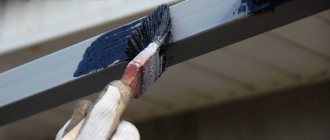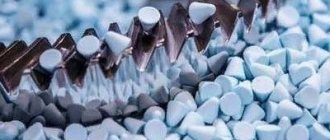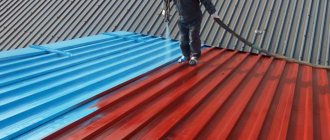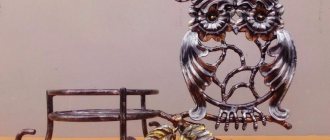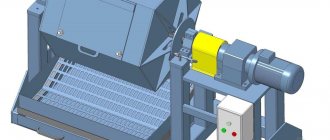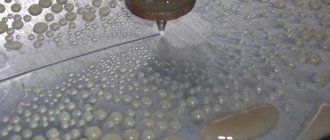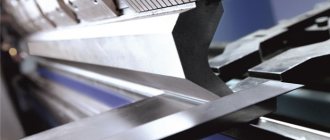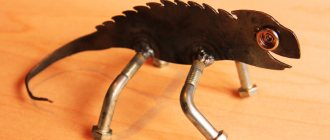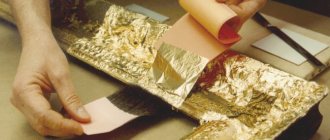Ceramic abrasive bodies (chips) for vibration tumbling processing There are a great variety of consumables for vibration tumbling processing abrasive bodies can be ceramic, porcelain, vulcanite, plastic, polyester, compounds (chemical compositions for vibration processing) can be acidic, alkaline, neutral, supplied in the form of paste, powder and liquid concentrate for diluting an aqueous solution. The variety of consumables available on the market allows us to select optimal unique technical processes for specific customer parts, which depends on the experience of the supplier and his desire (ability) to test different processes in his laboratory.
Polyester cones 12x14 mm (suitable for grinding non-ferrous metals during vibratory finishing)
The catalogs of global manufacturers of abrasive bodies (chips) and compounds for vibrating finishing, as well as some domestic ones, are very large, and, as a rule, to select the right set of abrasive and compound for a specific production task, one cannot do without consulting a specialist. Below we provide examples and descriptions of typical consumables for your understanding.
Stone tumbling at home
It is almost impossible to grind stones at home and without special equipment. For a single tumbling, you can use some available tools, but the quality of the work cannot be compared with specimens processed using professional equipment.
Tumbling stone using a concrete mixer
To clean stones from dirt and rough grinding at home, you can use a concrete mixer. To do this, the samples to be processed are placed in a concrete mixer, an abrasive filler or detergent is added to it and turned on at a certain speed. It is advisable to pre-build a cover to cover the drum window.
In this way you can tumble medium and large stones. Small samples will be difficult to separate from the abrasive media and are more likely to be damaged.
Machine for tumbling stone at home
If you regularly need to tumble stones at home, you can build a special machine. To do this, you will need a small cylindrical container with a lid, an electric motor (you can take it from a fan or an old washing machine) and a small shaft that will drive a homemade drum. You can also use the shaft of an emery machine with adjustable speed, on which an abrasive wheel is mounted, as an electric drive.
A small amount of stones and abrasive material is placed in a container that is fixed to the machine. After turning on the homemade installation, the stones are ground in with an abrasive filler.
Stone tumbling by hand
Stones with a high level of fragility and softness can be processed manually at home. To do this, you will need a container of water, a metal plate measuring 20x10 cm and fine-grained sandpaper.
Sandpaper is wrapped around a metal plate and then dipped in water. Take a stone in your hands and alternately grind all its edges on sandpaper until they acquire a rounded shape. Periodically, sandpaper must be moistened with water.
This method cannot process a large number of stones, and the quality leaves much to be desired.
Scope of application of tumbling stones
During the tumbling process, natural stone acquires a smooth surface and a unique shade. This allows it to be used in various fields:
- Jewelry making . Tumbling of precious stones is used for their preliminary processing. The samples are polished until the existing defects are eliminated and the surface becomes perfectly smooth. Quite often, the crystal size is reduced several times compared to the untreated mineral. Subsequently, the master carries out finishing processing of the stones and cutting them.
Amethyst beads tumbling
- Craftsmanship . Tumbling is used to make jewelry, magic items and souvenirs. Stones of various shapes and sizes make beautiful pendants, bracelets, beads, necklaces and keychains. Polished stones are used in lithotherapy for massage manipulations and the treatment of nervous disorders.
Carnelian beads tumbling
- Interior decoration . Many decorative elements are made from tumbling stones, which are subsequently used for interior decoration. Processed natural stone is used to cover floors and walls in the bathroom, lay out mosaics and panels, and line fireplaces and stoves. Polished samples are included in compositions of interior items.
Fireplace tumbled stone
- Construction and finishing works . Galvanized stone is widely used in finishing the facades of buildings, for laying paths and steps. The polished natural mineral has high practical properties and an aesthetic appearance. Typically, slate, rubble, sandstone, marble or granite are used for these purposes.
Galvanized stone on the facade
Tumbling machines
| Price, t. rub. | ||
| Tumbling vibrating machines | ||
| 1 | Tray type tumbling vibrating machine 20/15 L. | 75 |
| 2 | Tumbling post 20/15 L. | 95 |
| 3 | Tray type tumbling vibrating machine 50/30 L. | 95-110* |
| 4 | Trough type tumbling vibrating machine 50/30 L. (1 kW, 3000 rpm) | 105 |
| 5 | Tumbling post 50/30 L. | 105-120* |
| 6 | Tumbling station 50/30 L. (1 kW) | 115 |
| 7 | Tumbling station 50/30 L. with rotating separator | 260 |
| 8 | Tray type tumbling vibrating machine 150/120 L. | 195-220* |
| 9 | Trough type tumbling vibrating machine 150/120 L. (1.5 kW) | 210 |
| 10 | Tray-type tumbling vibrating machine 150/120 L. for processing car wheels up to R22 | 270-295* |
| 11 | Tray type tumbling vibrating machine 200/150 L. | 250-270* |
| 12 | Tray-type tumbling vibrating machine 200/150 L. for processing car wheels up to R22 | 325-345* |
| 13 | Programmable control rack for vibrating machines (universal control cabinet) | 40 |
| Tumbling drums | ||
| 1 | Tumbling drum | 150 |
| Optional equipment | ||
| 1 | Working fluid regeneration station for 50 l. (SRRZh50) | 8 |
| 2 | Pump for SRRZh | 2 |
| 2 | Polyurethane partition for GVM150/120 and GVM200/150 | 7 |
| 3 | Partition made of corrosion-resistant steel for GVM50/30 | 4 |
| 4 | Console for processing car rims up to R22 | 75 |
*Equipment prices depend on the configuration.
All equipment is new!
Free delivery of equipment throughout Russia!
Playlist on YouTube: “Processes and results of tumbling.”
Playlist on YouTube: “Equipment”.
Join the VKontakte group: https://vk.com/cnc42
The price depends on the configuration. See more detailed description.
Parts processed on www.CNC42.ru machines from corrosion-resistant steel (stainless steel) grade 12Х18Н10Т (AISI 304, 316, 403)
Mirror finishing of drill bits made of 65G black steel and hard alloy
Tumbling station 50 liters with a rotating drum separator April 2022
Operation of the tumbling station in different modes, unloading of parts, processing results
Tumbling vibrator 50 liters 2022
Vibrator operation in different modes, filler unloading
Tumbling vibrator 150 liters 2022
Vibrator operation in different modes, filler unloading
Tumbling station 50/30 liters (new model 2022)
In the video you will see a general view of the machine, start/stop, frequency adjustment, processing, unloading
Tray type tumbling vibrating machine 200/150 liters
In the video you will see a general view of the machine, start/stop, frequency adjustment, processing, unloading, finished parts
Tray-type tumbling vibrating machine 150/120 liters for processing car wheels up to R22
In the video you will see a general view of the machine, start/stop, frequency adjustment, disk installation, processing
Tray type tumbling vibrating machine 20 liters
In the video you will see a general view of the machine, start/stop, frequency adjustment, processing and unloading, at the end there is a small slide show
Tumbling station 50 l.
Operation of the tumbling station in various modes: processing, separation, unloading
Tumbling vibrator 150 liters
Vibrator operation in different modes, processing of large and small parts for 4 hours, unloading of filler, at the end of the video there are photographs of parts before and after processing
Porcelain ball processing
Vibrator 50/30 l.
Wood processing (wood finishing)
Vibrator 50/30 l.
Tumbling fillers
The type of filler directly determines the degree of final processing, be it polishing or grinding the material. The filler for tumbling is selected in accordance with certain requirements
First of all, you need to pay attention to the following factors:
Depending on the type of part used, the abrasive is suitable for finishing ceramic, wood, porcelain, plastic, sand, glass or even nut shells.
- Size of material for tumbling. The size must be selected in such a way that the balls can penetrate small holes, recesses and other hard-to-reach places in the part without getting stuck in them.
- Selection of the shape of the abrasive body. The degree and quality of processing depends on the shape of the body. Depending on the goals, a prism shape can be selected, which allows you to qualitatively get rid of burrs, rounding edges and primary grinding, a cone - for polishing and smoothing smooth surfaces, and a ball - for processing products of complex shapes.
- Select an abrasive based on the required abrasive properties. The degree of processing can vary, from primary grinding to remove large cracks and burrs, to polishing to give a smooth, shiny surface. For example, ceramic tumbling fillers are excellent for rough finishing and large layer removal.
Today, the market offers a huge range of abrasive materials, both domestic and imported. It is worth noting that the quality of the filler practically does not vary depending on the manufacturer. Therefore, you don’t have to overpay when purchasing filler. You can only take the manufacturer into account when choosing plastic, since the performance characteristics and service life depend on the quality of the raw materials.
If you plan to use tumbling equipment for home purposes and processing simple metal parts, it is not necessary to purchase factory filler. Depending on the purposes of processing, improvised materials such as pebbles, finely broken glass or the remains of broken ceramic dishes can be used. For small equipment, 10 liters of such filler will be enough, which can be used repeatedly.
With proper operation of tumbling equipment and selection of appropriate filler, high-quality processing of workpieces can be achieved. The efficiency of tumbling significantly exceeds the efficiency of manual processing.
If you find an error, please select a piece of text and press Ctrl+Enter.
It is used for dry processing of products made of precious metals in tumbling of any type. No paste impregnation. Please add polishing or grinding paste before use.
Paste dosage – 2-3 teaspoons (depending on the operation) for every 5 kg of filler. Material: walnut shell. The size of the granules is 2.4-4.0 mm.
Price per 100 grams.
- In stock 65.00
Abrasive fillers (tumbling bodies) on a polymer binder
High-quality polymer abrasive fillers (plastic) for all types of finishing installations. Used for more delicate processing of metals (stainless steel, aluminum, copper, brass). There is a wide variety both in filler shape and aggressiveness, and in size. Allows you to perform a wide range of grinding operations: from rough grinding to polishing, reaching Ra class 12.
| Cone | 10x10, 12x15, 20x20, 30x30, 60x60 |
| Paraboloid | 20x20x11, 30x30x17, 40x40x20 |
| Pyramid concave | 10x10, 15x15, 20x20, 30x30, 40x40 |
| Pyramid | 10x10, 15x15, 20x20, 30x30, 40x40 |
| Beveled prism | 10x10, 20x20, 30x30, 40x40 |
Aggressiveness of the abrasive filler: extra coarse grain (EGZ), very coarse grain (OGZ), coarse grain (GZ), medium coarse grain (SGZ), medium grain (SZ), fine grain (TZ), super fine grain (STZ), extra fine grain (EFG).
Processing in a tumbling drum (tumbling)
Tumbling metal in Moscow really proves that everything ingenious is simple. To carry out the process, only three components are required: the part itself, abrasive substances for cleaning and a container (drum) in which the cleaning will take place. A wide variety of substances—particles—can serve as fillers (abrasives) for tumbling:
- ceramics,
- wood,
- plastic,
- glass,
- porcelain.
For some types of processing, even the shells of coconuts or walnuts are used. For more complex and effective tumbling methods, for example, for tumbling copper, additional substances can be added to the abrasives. For example, water and the so-called compound. The latter refers to a combination of several chemicals designed not only to clean the metal, but to give it a characteristic gloss. Inhibitors, stearin and coagulants are usually used as components of the compound.
Trough tumbling
Tray tumbling is a process of finishing products using a vibrating tray-type tumbling machine. A trough tumbling machine in a simplified form is a rectangular tumbling drum (bath), with an electric motor with a vibration drive attached to the bottom. To operate large tray machines and, accordingly, high power, one electric motor is not enough; in such machines, two motors with a vibration drive are installed for each of them.
The movement of the tumbling filler together with the workpieces in the machine drum during its operation has a circular trajectory relative to the longitudinal axis of the drum. Unlike the trajectory of movement of the filler in the drum of a round-type tumbling machine, in which the abrasive material moves along a circular path that follows the surface of the torus, in tray-type tumbling machines the filler moves along a trajectory that follows the surface of the cylinder.
The main advantage of tray-type finishing machines is the ability to process large-sized, body-shaped and long workpieces. Such workpieces cannot be processed by tumbling in any other machine, and the use of manual processing is much more expensive, and sometimes impossible, due to the shape and dimensions of the workpieces.
The design of a trough tumbling vibrating machine in the form of an elongated bath has one significant drawback compared to a round vibrating machine. In such a machine, it is difficult to remove processed products from the tumbling bath. As a rule, large-sized products are processed in tray-type machines, which allows them to be loaded and removed manually from the tumbling drum.
In some cases, during tumbling of magnetic workpieces, an electromagnetic separator can be used, which will greatly facilitate the separation of products in the tray drum.
When using a tray vibrating machine, there is often a need to process small workpieces; in this case, the best solution for separating the workpieces from the abrasive filler is to use an external vibration separator.
Of course, this significantly increases the cost of the finishing machine, but allows it to be used in a wide range of processed workpieces. Structurally, the filler and workpieces are unloaded through the unloading hole on the side wall of the tray drum. The external vibration separator produced by KROMASH has a reduced height of the receiving tray for convenient use in conjunction with tray vibrating machines.
To integrate a trough tumbling finishing machine into a production line, the KROMASH company can offer another type of trough machines - the so-called. through-type tray machines.
Linear finishing system - LNR (Linear Vibratory Continuous Finishing System) is a vibratory machine that is designed in such a way that during operation the tumbling bodies, together with the products, move from one end of the machine to the other. Processing of workpieces occurs while the workpieces move along the entire working length of the vibrating chute. After the filler passes through the working area, the workpieces being processed along with the abrasive filler enter the separator. After separation at the separator, the tumbling stones are loaded back into the machine using a mini feed conveyor, and the processed products are moved to the next technological operation.
In addition to integrating LNR Linear Finishing Systems into automated continuous cycle lines for the production of small parts, there is another application for such systems - for the processing of long pipe blanks. For detailed information about LNR Linear Finishing Systems, ask our company’s technical specialists.
The KROMAS company produces special trough-type tumbling vibrating machines that will help you cope with the processing of products of any form of complexity, ensure ideal cleaning and contribute to process consistency.
Technologies and equipment for tumbling
The tumbling process is carried out on various equipment, for example, tumbling drums and tumbling vibrating machines of various types.
To carry out the tumbling process, a filler (medium) is required in which the workpieces are processed and the required quality and roughness of the machined surface of the part is ensured.
The filler and parts are set in motion relative to each other in the working capacity of the machine (drum).
Tumbling machines are divided into a large number of types, for example: mechanical and electromagnetic, in turn, mechanical ones are divided according to the type of movement into rotating drums and drums with a vibration drive.
Tumbling drum
Tumbling drum
This is the most primitive and affordable machine for finishing material. It is made in the form of a multifaceted drum or cylinder. In relation to the axis it can be either standardly horizontal or vertical, or at a certain angle.
The drum is started using an electric motor. Finishing and cleaning of stone is carried out by mixing materials and abrasive chips in free space during operation of the installation. This machine is considered the most affordable option for private jewelers.
Vibration installation
Tumbling vibrating machine
The machine is the same drum of a certain shape with a vibration drive mounted on the body. The tumbling mixture and materials for processing are loaded inside the drum. Additionally, solutions of compounds for wet type processing can be added.
The operating technology of the machine is as follows. An electric motor with a vibration drive of a drum with abrasive and processed material starts the machine. As a result of oscillatory movements, processing materials and fillers move inside at a certain speed. The result of the movement is microimpacts on the surface of the stone with the removal of the top layer from the surface - grinding and polishing.
Rotary centrifugal machine
Centrifugal tumbling
The most modern version of finishing equipment is a centrifugal rotary machine. The operating algorithm is based on the use of a vertically fixed stationary compartment with a rotating plate and blades in the lower part.
The compartment is completely filled with tumbling mixture and the machine is started. As soon as the actuator begins to rotate, the tumbling mixture begins to move along with the workpieces being processed.
Towing rig
Towing tumbling
Equipment of this type is used less frequently than the previous ones. The machine works like this: the product is fixed on a spindle, after which it is set in motion and lowered into the working surface with a prepared abrasive filler.
When the filler comes into contact with the product, a thin layer of material is removed from the latter in a short period of time. In order to supplement or update the filler, the spindle is launched in a new direction relative to the bowl with bodies, or a vibration drive is connected to it.
The “towing” installation is not designed for simultaneous processing of large batches of material and this is its main drawback.
The advantage is the high level of quality of finishing in a short time.
Recommendations
Each piece of jewelry is a memory of certain events, and in order to preserve them for many years in a decent form, careful care is required, the features of which can be found in our blog, in the article “The eternal beauty of jewelry - how to preserve it?” Grinding and polishing is an excellent method that will help restore jewelry to its former beauty and radiance, but you should not do this very often, because in the process a layer of material, albeit insignificant, is removed.
In the UvelirMoscow design studio you can not only make magnificent jewelry masterpieces to order, but also repair, grind and polish your precious items.
Purpose of metal tumbling
As mentioned above, metal tumbling allows you to remove the following defects from the surface of products:
- sharp edges when stamping sheet metal products;
- burrs formed during cutting of workpieces or turning;
- scale after welding or metal cutting;
- remnants of flash from parts made by casting.
In addition, tumbling effectively polishes products to a mirror-like surface. Parts that have been subjected to tumbling can then be subject to galvanic treatment or painting with powder mixtures.
What metals can be tumbled:
- special purpose alloys;
- black metal;
- structural steel;
- AISI stainless alloys;
- titanium materials;
- aluminum and its alloys;
- copper and copper-based alloys;
- silver products.
Abrasive fillers on a ceramic bond
| Triangle, beveled triangle | 6x13, 7x10, 10x16 |
| Triangular prism | 4x4, 6x6, 10x10, 15x15, 20x20, 25x25, 30x30 |
| Beveled triangular prism | 4x4, 6x6, 10x10, 15x15, 20x20, 25x25, 30x30 |
| Ellipse, beveled ellipse | 10x5x10, 15x7x15, 25x15x25 |
| Cylinder, beveled cylinder | 3x6, 5x10, 6x12, 10x16 |
| Ball | 2, 3, 4, 5, 6, 8 |
Aggressiveness of the abrasive filler: very coarse grain (OGZ), coarse grain (GZ), medium grain (SZ), fine grain (FG).
High-quality non-abrasive ceramic polishing fillers (porcelain) allow you to perform polishing operations after grinding and reach 10 ... 11 Ra roughness classes. Metal fillers are used to polish and harden the surface of products.
| Ball | 2, 3, 4, 5, 6 |
| Cylinder | 1x3, 2x5, 3x10, 5x10, 6x10 |
| Beveled cylinder | 3x10, 5x10, 6x12 |
| AISI satellite | 3x5, 5x7 |
| AISI cylinder | 2x5, 3x10, 5x10, 6x10 |
| Ball AISI | 2, 3, 4, 5, 6 |
Types and technologies of tumbling
Stone tumbling is carried out in several ways, taking into account the characteristics of the natural mineral, the method of its processing and fastening, as well as the type of mixing and the abrasive filler used. There are several types of equipment designed for tumbling stones.
Tumbling drum
Tumbling drum
The installation is of the most primitive type, having the form of a cylindrical or hexagonal prismatic drum. The machine can have different dimensions and be used both in large-scale production and by private jewelers.
The installation is easy to operate and is driven by an electric drive. An abrasive filler is loaded into it, which, due to the high speed rotation of the drum, grinds the stones.
Despite the ease of use, the tumbling drum has some disadvantages:
- It is difficult and almost impossible to perform uniform grinding of stones of complex shapes and delicate finishing of small samples;
- the design of the drum does not allow observation of the tumbling process;
- The car makes a lot of noise, which requires soundproofing.
Tumbling vibrator
Tumbling vibrator
The equipment also has the form of a drum, which is driven by a vibration drive. Stones and an abrasive mixture are placed in the drum; it is also possible to use liquid compositions for processing using the “wet” method.
When the machine starts, not rotational, but oscillatory movements occur; the contents of the drum begin to move inside in a certain order and speed. As a result, the top layer of the stone is delicately removed, the surface is ground and polished.
Due to the versatility and softness of processing, as well as the ability to observe each stage of processing, this type of installation is used by most jewelry makers.
Centrifugal type rotary machine
Centrifugal tumbling
One of the most common types of tumbling equipment, in which the tumbling mixture and processed stones are driven by blades. The drum, fixed motionless in a vertical position, is equipped with a rotating tray and blades inside. After loading the stones and abrasive filler, the machine turns on and the tray with blades is set in motion.
The advantages of this type of machine are:
- high performance;
- quality of finishing;
- possibility of adjusting the speed of rotation of the pallet;
- Possibility of grinding large batches of stones.
Along with the advantages, this machine also has disadvantages. These include the impossibility of processing large stones, low wear resistance of the internal part of the compartment and the high cost of the equipment.
Tumbling "towing" installation
Towing tumbling
The equipment is not intended for processing large quantities of stones, so it is rarely used. The unit is used to grind and polish single-piece products that require high-quality finishing.
The stone to be processed is fixed on a spindle, which is then set in motion and lowered into a container with abrasive filler. As a result, a thin layer is removed from the surface of the stone in a short period of time.
Tumbling equipment
Various types of equipment are used in production; each model has certain advantages and disadvantages. Therefore, before choosing a model, it is worth studying its features and characteristics in detail.
Among the most common models for the head of parts are:
- Tumbling drum:
This is the simplest type of equipment, which is a cylindrical drum, less often multifaceted. An electric motor is installed at the base of the drum, causing it to rotate. The drum can be positioned vertically, horizontally or at an angle. It is better when it is possible to change the working angle.
To operate, the required amount of abrasive and workpieces is loaded into the drum. Processing of materials occurs due to the constant movement of workpieces in an abrasive environment during the rotation of the container.
The main advantage of this model is its simplicity and low cost. You can make the drum yourself at home. It is great for household plots and small businesses.
But, given a number of shortcomings, such drums are gradually being phased out and replaced by more advanced models.
The main disadvantages include:
- low speed of work, which negatively affects the efficiency and cost of work;
- there is no separation system, which complicates the process of separating products and finishing bodies;
- most models provide only dry processing; it is almost impossible to implement wet processing in practice;
- In drums, only durable products of simple geometric shape can be processed; processing of thin-walled products from fragile materials or objects of complex shape is ineffective;
- such models do not provide for the possibility of visual control of the processing process while the machine is operating; you need to constantly stop the drum and look for the workpiece in the mixture;
- such equipment does not allow achieving uniform surface treatment, therefore it is more suitable for grinding than polishing;
- the drum creates a lot of noise during operation, sometimes strong vibration, so it cannot be used near residential premises, or the workshop needs to be equipped with additional noise insulation.
Due to a large number of shortcomings, drum equipment today is used only in extreme cases when simple surface treatment is required without achieving high quality, or when the treatment is one-time in nature. For such purposes, sometimes a concrete mixer is used, I slightly re-equip it. A drum like this is perfect for removing casting marks.
- Vibration equipment.
It is this type that replaced the drums and is the most popular today. It is based on a working container of various shapes, which can be in the form of a drum, cube, pipe, bath or other shape. A vibration drive is attached to the container. The tumbling bodies and the processed material are loaded into the container. This model allows the use of water and compound.
The vibration drive is driven by an electric motor, transmitting vibrations to the loaded mixture. The vibration of the abrasive seems small and almost unnoticeable, but such movement allows for high-quality cleaning of the surface due to the rapid and frequent movement of the components relative to each other. The chips apply micro-impacts to the workpiece, which allows you to clean the surface even in the deepest and most difficult areas.
Vibration equipment is constantly being improved, which can significantly increase its efficiency and productivity. Some models include the installation of a mixer, which additionally rotates the working mixture. Today it is easy to choose a model of any size and power. It has practically no disadvantages, and among the advantages are the following:
- versatility, due to the ability to process workpieces of various sizes and shapes, as well as thin-walled objects and fragile raw materials, you just need to replace the finishing bodies, as well as adjust the power and vibration parameters;
- high productivity, which is achieved due to large working tanks made of powerful electric motors; most models also allow simultaneous processing of workpieces of various types with similar physical parameters;
- high speed, significantly exceeding the speed of drum models;
- allows you to process products and soft materials;
- During the work, you can visually control the result; often you can even remove the workpieces without turning off the equipment.
- Rotary equipment.
A simple but quite effective type that is becoming increasingly popular. It is based on a cylindrical container, which is fixedly fixed to the frame. At the base of the container there is a rotating shaft with blades. The working mixture is simply poured into the drum from above. The shaft is then driven by an electric motor, creating centrifugal motion inside the container. To ensure that the mixture moves evenly around the drum and does not get caught on the edges, the walls of the container are specially profiled. This creates a planetary trajectory for the mixture.
Among the disadvantages of rotary equipment are the ability to process only small, light objects, rapid wear of the walls and bottom of the drum, especially at the point where the container and shaft are attached.
The main advantages are:
- the highest productivity among analogues;
- allows you to simultaneously load a large volume of workpieces;
- by changing the shaft rotation speed, you can control the degree of surface roughness of the part with high accuracy;
- the highest quality of processed surface over the entire area of the workpiece;
- Equipment manufacturers often provide the ability to easily add and drain reagents used in the tumbling process.
- Spindle equipment.
A modern type of equipment that is used in rare cases due to its high complexity. At the same time, it shows the highest quality processing result. Therefore, in some cases, spindle equipment becomes indispensable in production.
Unlike other models, the workpieces are not in the free space of the abrasive mixture; they are attached to a spindle, which is rotated. The rotating spindle is slowly lowered into the working container with the abrasive mixture. Thanks to the high spindle speed, the abrasive quickly cleans and polishes the surface of the part. The spindle constantly moves in the mixture so that the abrasive particles replace each other.
The only drawback of this processing is the inability to work with a large number of parts, which is limited by the number of fasteners on the spindle. Most often, such equipment can be found in high-precision mechanical engineering, where special requirements are placed on the surface of parts.
What is tumbling?
Tumbling is the name given to stones of a natural, slightly rounded shape, polished on all sides. Most often, such inserts are used in beads, bracelets and necklaces.
This is one of the few methods of stone processing that is performed automatically: jewelry made from gems processed in this way is the most accessible.
Raw stones of similar size, shape and hardness along with abrasive powder are poured into a metal drum. The whole structure rotates and rattles (sometimes for several days), after which it produces nice polished pebbles. All that remains is to drill holes for the thread - and you can assemble the decoration.
But handmade tumbling is especially valued and most beautiful. The fact is that pebbles rotating in a drum are evenly ground down on all sides, and natural material, as a rule, has rather deep cavities and cracks. As a result, by the time all the defects are sanded away, very little remains of them. Working with each stone individually, the master can “pull out” a much larger volume from a natural pebble of the same size, and, in addition, leave only that part of it that has the most expressive pattern.
Where are tumbling stones used?
Due to its characteristics and wide range of colors, this finishing material is used:
- In jewelry. Thanks to the targeted impact on the surface of natural stone, all sharp corners are erased and the material becomes smooth. Such a stone can be carried in a bag or pocket, enclosed in a graceful and elegant frame and worn on the chest as an amulet. Stones of various shapes and sizes make beautiful pendants, bracelets, beads, necklaces and keychains.
Carnelian beads tumbling
- As one of the options for finishing the facade of a house or its base, for creating decorative elements and for other external works.
Galvanized stone on the facade
- For interior design. Natural stone, processed using a special technology, can be used to decorate both the walls of a room and individual parts (for example, fireplaces). Islands made of natural rounded stone create a unique style and emphasize the taste of the home owners.
Fireplace tumbled stone
- When decorating artificial ponds and fountains of varying heights and complexity. Water perfectly highlights the shades of the stone and the beauty of an interesting composition.
Tumbled stone pond
- In landscape construction for creating garden paths and finishing fences. Resistance to mechanical stress and the ability to withstand various weather conditions make tumbled stone in demand among landscape designers.
Galvanized stone for paths
- To create an interesting interior in aquariums. The stone is very reminiscent of a sea stone in appearance, which allows the owner to create an interesting composition against which the inhabitants of the aquarium will look most advantageous.
Aquarium with tumbling stone
- For creating large-area coverings - areas for summer cafes, walking areas, pedestrian paths. The area covered with rounded stone is suitable for use at different temperatures and is not afraid of moisture. An undeniable advantage is ease of care and maintenance.
Cafe area with tumbled stone
Equipment for tumbling and the essence of this technology
Press releases 01/14/2020 10:33
Ideally smooth metal parts that lie on store shelves do not come out right away. In any case, during production, some defects are formed, which are subsequently removed by a finishing machine. The material is affected by bulk abrasive, which is located inside the machine along with the part. By vibration or rotation, metal products are polished and cleaned. Thus, all parts acquire a finished, marketable appearance. Small particles of emery, sand and other materials are used as an abrasive. They are used for dry tumbling. There is also a wet one. Special solutions are used for it.
There are several types of tumbling equipment. The first involves rolling products in special drums. It has the shape of a polyhedron with a lid to prevent harmful dust from the abrasive from getting out. The drive is an electric motor, and the rotation shaft is located horizontally. This type of device is suitable for processing flat products.
The next type is a centrifugal machine. In its shape it resembles a bell. The body is made of metal, the thickness of which is approximately 3 mm. The inside is covered with plastic or rubber so that the steel does not spoil the parts. In such machines, threaded hardware is most often subjected to tumbling. Parts that are medium and large in size are subjected to tumbling using the vibration method. For this purpose, the products are placed in special equipment (chambers). There are special mechanisms inside that create vibrations. The chamber oscillates at a certain frequency at which the workpieces and abrasive move in a unique way.
Consumables are used for each type of tumbling. These are various fillers: dry abrasives that can be washed into dust; paste; bodies. The latter include especially solid substances that have a certain shape and fraction. This can be steel shot, zirconium, emery, ceramic particles, etc. The effect of using such materials for tumbling is similar to polishing of varying degrees. The essence of tumbling is to clean the product from dust, corrosion, scratches, etc.
| If you find an error in the text, highlight it and press Ctrl + Enter |
Organic fillers
| Polishing filler (walnut) is used for all types of tumbling installations with the addition of polishing paste, light drying effect. Application: polishing products after preliminary grinding. Fractions: 0.5 – 1 mm, 1 – 3 mm, 3 – 5 mm. | |
| Drying filler SSK (sorbent) is used in vibration drying units with hot air supply. Application: drying of products after processing in tumbling installations with a light polishing effect. Fractions: 1 – 3 mm, 3 – 5 mm, 4 – 6 mm. |
Drum tumbling, buy tumbling drum
Drum tumbling is intended for cleaning the metal surface from corrosion, rounding edges, removing burrs, and cleaning stamped and cast parts. The parts are removed manually into a container on a pallet. ADDITIONAL. EQUIPMENT
|
| *Control unit with timer is included in the price.. |
| Select and order |
MODEL Nominal drum diameter, mm Working volume, l Power, kW Voltage, V Cost, rub. Internal polyurethane coating
| MAG-2 | 100 | 2 | 0,15 | 220/380 | 20000 | 9000 |
| MAG-6 | 150 | 6 | 0,15 | 25000 | 10000 | |
| MAG-15 | 200 | 15 | 0.25 | 85000 | 12000 | |
| MAG-20 | 225 | 20 | 0,5 | 90000 | 15000 | |
| MAG-27 | 250 | 27 | 0,75 | 95000 | 17000 | |
| MAG-47 | 300 | 47 | 1,1 | 100000 | 18000 | |
| MAG-60 | 325 | 60 | 1,1 | 110000 | 19000 | |
| MAG-74 | 350 | 74 | 1,1 | 150000 | 19500 | |
| MAG-91 | 375 | 91 | 1,5 | 165000 | 21000 | |
| MAG-111 | 400 | 111 | 1,5 | 380 | 175000 | 23500 |
| MAG-217 | 500 | 217 | 1,5 | 190000 | 25000 | |
| MAG-280 | 600 | 280 | 4,0 | 250000 | 27000 | |
| MAG-446 | 700 | 446 | 7,5 | 300000 | 37000 | |
| MAG-665 | 800 | 665 | 11 | 450 000 | ||
| MAG-947 | 900 | 947 | 11 | choose | ||
| MAG-1300 | 1000 | 1300 | 15 | choose |
Order selection of technology and tumbling bodies
Tumbling machine
The Engineering Center produces drum finishing machines of various sizes.
COMMON DATA
Tumbling is designed to clean metal from scale and corrosion, and also allows you to round off sharp edges and remove burrs. Tumbling drums of hexagonal and cylindrical shape are used as equipment. Hexagonal drums provide optimal processing results when finishing various products.
The process of processing parts in a tumbling drum is as follows (see figure): when the drum rotates, the volume of parts in abrasive particles rises to the top, and an avalanche-like working area appears, in which the continuous process of cleaning parts occurs.
By design, tumbling drums can be divided into:
- two-support;
- two-support with an inclined axis;
- console (bell);
- perforated drums for wet finishing;
- special.
Tumbling drums differ in the design of the support units, the fastening of the lid, and the presence or absence of partitions inside. Partitions are used when processing small parts.
When processing heavy, large parts, such as castings, the chamber size is made so that one or two parts fit into the chamber.
When processing hard materials (stone, shot, etc.), small diameter drums are used.
Tumbling drums with an offset axis create complex, intense movement of parts inside the drum, as well as good mixing of them with abrasive material. During one revolution, the speeds of movement of parts are different, processing occurs more intensively and efficiently.
For fine grinding of parts (polishing and superfinishing), perforated tumbling drums operating in a special liquid are used.
Technical description of tumbling machines of the MAG series
Tumbling drums of the MAG series have a special polyurethane coating on the inside, which reduces noise during operation and also extends the service life of the drum.
We install speed controllers on all tumbling drums. The maximum speed of our tumbling machine is 35-45 rpm. The larger the drum diameter, the lower the rotation speed. For example, for a diameter of 500 mm, the rotation speed should be 30-40 rpm, for a diameter of 800 mm no more than 25 rpm.
A free-standing portable control panel increases the ergonomics of finishing equipment and ease of use.
We produce various tumbling drums, which you can buy by filling out an application.
When ordering a drum tumbling machine from us, you can count on high quality tumbling equipment and reliable support throughout its entire service life.
You can buy tumbling in Moscow from us around the clock, leave a request and we will contact you as soon as possible.
Tumbling: features of processing metal products
As a rule, a frequency of 10-50 rpm is used for tumbling in bells, and 20-60 rpm in drums. The drums in which tumbling is carried out have a hexagonal or octagonal shape. Also, such equipment is characterized by the presence of a cover. Sheet steel is used for manufacturing. Increasing the quality of mixing is accompanied by the presence of longitudinal corners inside. This is also achieved by rotating around an inclined axis. Equipment made of steel is lined inside with the following materials:
- plastics;
- rubber;
- tree.
The bell in which tumbling is performed is made of sheet steel 3 mm thick. This equipment uses the following materials to remove defects from the surface of metal products:
- emery;
- quartz sand;
- marble and porcelain battle;
- ceramic prisms.
Metal tumbling: types, fillers, technology – Turner
Good day, dear Kulibins.
___Three years ago I came across this post (links are prohibited)???? It’s a shame, there’s a beautiful picture there. The picture really stuck with me. But at that time I did not have a decent car on which I could use such beauty or technical capabilities. And polishing by hand didn’t really inspire me.
____Time passed... I slowly became interested in polishing. And by chance I came across a description of mechanical polishing using stones/tumbling bodies/chips on the Internet.___This technology interested me very much.
And at the general council a decision was made! “TATTING” to be!___Those who read my blog with my old Rydvan probably remember how last summer I tried to put my alloy wheels in order (read the community rules)???? the link is not allowed, so instead of it???? “A lot of time was spent, but in the end there was little result.”
___And this spring it was decided to do the tumbling myself. They ask for too much money for a finished tumbling machine (and judging by the design, it will fall apart on the first disk).
- ___I went and bought a pipe + a plate, the rest was found in the repair area and after two months of welding work the process was completed.
- ___You can see how tumbling works in the first video you come across from the Internet.
___Over the course of a year, I collected information on the design of the installation itself. Unfortunately, I couldn't find any drawings. So I downloaded a few photos. And already focusing on them, he began to build a “ROCKET”????.
Full size
We assembled the tumbling using available materials. They sculpted what they found in the workshop.
Full size
They didn't chase beauty.
Full size
We installed two platform vibrators. Securing them at an angle of 45 degrees.
Full size
A frequency generator was also purchased to set the vibration frequency.
Full size
To attach the disk, a pipe was used, having previously cut a thread on it.
Full size
The body was made from a water pipe. How do you like its thickness?
Full size
Doesn't it seem like it can't be broken? But we did it. The seams were cut with a grinder and boiled. It's holding up so far, without the duct tape everything would probably have fallen apart.
Full size
The next surprise awaited us from vibration motors. This is outright trash. Bought new. They were assembled, stupidly, on Chinese bearings and without lubrication.
Full size
They learned that they had no lubrication when one motor burned out. We bought another one. We disassembled all the motors, replaced the bearings with normal ones, and lubricated them. While they are working.
Full size
Now about the couch experts. They brought these discs. Killed by industrial sandblasting. The surface of the disc was 60-grit sandpaper. It was possible to sharpen knives.
Full size
We bought shebenka (gravel) and struggled with the discs for a very, very long time.
Full size
After much torment, this is the result.
Full size
This is the maximum that can be obtained from tumbling in sand, shaben, gravel and other materials from a hardware store. There was plenty of time, we tried everything.
Full size
Well, after the gravel, tumbling bodies (chips) of three different fractions were used. Rough grinding. Preliminary and final sanding. At all stages of vibro-polishing, special chemicals are used. Without it, just like without chips, beauty cannot be achieved.
And the result was masterpieces like these.

